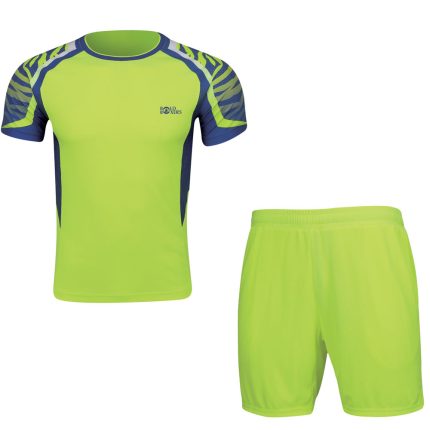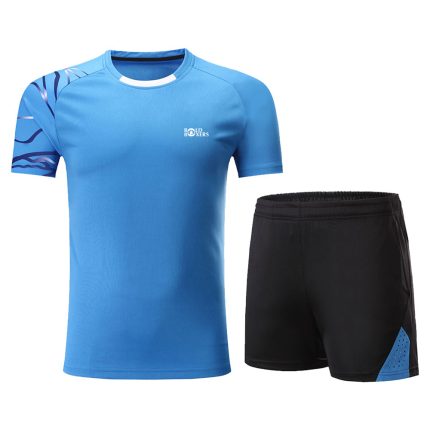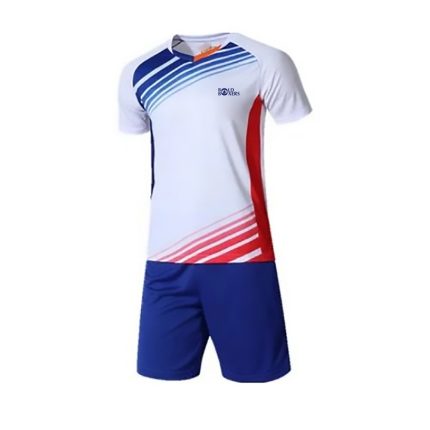Tennis Uniform
Tennis uniforms are designed to provide comfort, mobility, and style for players on the court. Here are the key components:
- Shirt: Tennis shirts are typically made from lightweight, breathable fabric to keep players cool and dry during matches. They may feature moisture-wicking technology and ventilation panels for enhanced comfort. Shirts often come in a variety of styles, including polo shirts, crew necks, and V-necks.
- Shorts/Skirt: Tennis shorts are designed for freedom of movement and typically feature an elastic waistband and moisture-wicking fabric. Skirts are also popular for female players, offering comfort and style on the court. Both shorts and skirts come in various lengths and styles to suit player preferences.
- Socks: Tennis socks are made from moisture-wicking materials to keep feet dry and comfortable during play. They provide cushioning and support to reduce the risk of blisters and injuries. Tennis socks may also feature arch support and padding in high-impact areas.
- Shoes: Tennis shoes are specially designed to provide traction, stability, and support on the court. They feature durable outsoles with grip patterns optimized for lateral movements and quick direction changes. Tennis shoes also offer cushioning and shock absorption to protect players' feet and joints during play.
- Headwear (optional): Some players choose to wear caps, visors, or headbands to keep sweat out of their eyes and maintain visibility during matches
Tennis Uniform
Tennis uniforms are designed to provide comfort, mobility, and style for players on the court. Here are the key components:
- Shirt: Tennis shirts are typically made from lightweight, breathable fabric to keep players cool and dry during matches. They may feature moisture-wicking technology and ventilation panels for enhanced comfort. Shirts often come in a variety of styles, including polo shirts, crew necks, and V-necks.
- Shorts/Skirt: Tennis shorts are designed for freedom of movement and typically feature an elastic waistband and moisture-wicking fabric. Skirts are also popular for female players, offering comfort and style on the court. Both shorts and skirts come in various lengths and styles to suit player preferences.
- Socks: Tennis socks are made from moisture-wicking materials to keep feet dry and comfortable during play. They provide cushioning and support to reduce the risk of blisters and injuries. Tennis socks may also feature arch support and padding in high-impact areas.
- Shoes: Tennis shoes are specially designed to provide traction, stability, and support on the court. They feature durable outsoles with grip patterns optimized for lateral movements and quick direction changes. Tennis shoes also offer cushioning and shock absorption to protect players' feet and joints during play.
- Headwear (optional): Some players choose to wear caps, visors, or headbands to keep sweat out of their eyes and maintain visibility during matches
Tennis Uniform
Tennis uniforms are designed to provide comfort, mobility, and style for players on the court. Here are the key components:
- Shirt: Tennis shirts are typically made from lightweight, breathable fabric to keep players cool and dry during matches. They may feature moisture-wicking technology and ventilation panels for enhanced comfort. Shirts often come in a variety of styles, including polo shirts, crew necks, and V-necks.
- Shorts/Skirt: Tennis shorts are designed for freedom of movement and typically feature an elastic waistband and moisture-wicking fabric. Skirts are also popular for female players, offering comfort and style on the court. Both shorts and skirts come in various lengths and styles to suit player preferences.
- Socks: Tennis socks are made from moisture-wicking materials to keep feet dry and comfortable during play. They provide cushioning and support to reduce the risk of blisters and injuries. Tennis socks may also feature arch support and padding in high-impact areas.
- Shoes: Tennis shoes are specially designed to provide traction, stability, and support on the court. They feature durable outsoles with grip patterns optimized for lateral movements and quick direction changes. Tennis shoes also offer cushioning and shock absorption to protect players' feet and joints during play.
- Headwear (optional): Some players choose to wear caps, visors, or headbands to keep sweat out of their eyes and maintain visibility during matches
Tennis Uniform
Tennis uniforms are designed to provide comfort, mobility, and style for players on the court. Here are the key components:
- Shirt: Tennis shirts are typically made from lightweight, breathable fabric to keep players cool and dry during matches. They may feature moisture-wicking technology and ventilation panels for enhanced comfort. Shirts often come in a variety of styles, including polo shirts, crew necks, and V-necks.
- Shorts/Skirt: Tennis shorts are designed for freedom of movement and typically feature an elastic waistband and moisture-wicking fabric. Skirts are also popular for female players, offering comfort and style on the court. Both shorts and skirts come in various lengths and styles to suit player preferences.
- Socks: Tennis socks are made from moisture-wicking materials to keep feet dry and comfortable during play. They provide cushioning and support to reduce the risk of blisters and injuries. Tennis socks may also feature arch support and padding in high-impact areas.
- Shoes: Tennis shoes are specially designed to provide traction, stability, and support on the court. They feature durable outsoles with grip patterns optimized for lateral movements and quick direction changes. Tennis shoes also offer cushioning and shock absorption to protect players' feet and joints during play.
- Headwear (optional): Some players choose to wear caps, visors, or headbands to keep sweat out of their eyes and maintain visibility during matches
Tennis Uniform
Tennis uniforms are designed to provide comfort, mobility, and style for players on the court. Here are the key components:
- Shirt: Tennis shirts are typically made from lightweight, breathable fabric to keep players cool and dry during matches. They may feature moisture-wicking technology and ventilation panels for enhanced comfort. Shirts often come in a variety of styles, including polo shirts, crew necks, and V-necks.
- Shorts/Skirt: Tennis shorts are designed for freedom of movement and typically feature an elastic waistband and moisture-wicking fabric. Skirts are also popular for female players, offering comfort and style on the court. Both shorts and skirts come in various lengths and styles to suit player preferences.
- Socks: Tennis socks are made from moisture-wicking materials to keep feet dry and comfortable during play. They provide cushioning and support to reduce the risk of blisters and injuries. Tennis socks may also feature arch support and padding in high-impact areas.
- Shoes: Tennis shoes are specially designed to provide traction, stability, and support on the court. They feature durable outsoles with grip patterns optimized for lateral movements and quick direction changes. Tennis shoes also offer cushioning and shock absorption to protect players' feet and joints during play.
- Headwear (optional): Some players choose to wear caps, visors, or headbands to keep sweat out of their eyes and maintain visibility during matches
Tennis Uniform
Tennis uniforms are designed to provide comfort, mobility, and style for players on the court. Here are the key components:
- Shirt: Tennis shirts are typically made from lightweight, breathable fabric to keep players cool and dry during matches. They may feature moisture-wicking technology and ventilation panels for enhanced comfort. Shirts often come in a variety of styles, including polo shirts, crew necks, and V-necks.
- Shorts/Skirt: Tennis shorts are designed for freedom of movement and typically feature an elastic waistband and moisture-wicking fabric. Skirts are also popular for female players, offering comfort and style on the court. Both shorts and skirts come in various lengths and styles to suit player preferences.
- Socks: Tennis socks are made from moisture-wicking materials to keep feet dry and comfortable during play. They provide cushioning and support to reduce the risk of blisters and injuries. Tennis socks may also feature arch support and padding in high-impact areas.
- Shoes: Tennis shoes are specially designed to provide traction, stability, and support on the court. They feature durable outsoles with grip patterns optimized for lateral movements and quick direction changes. Tennis shoes also offer cushioning and shock absorption to protect players' feet and joints during play.
- Headwear (optional): Some players choose to wear caps, visors, or headbands to keep sweat out of their eyes and maintain visibility during matches













